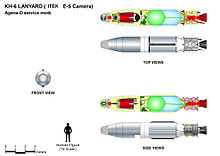KH-6 Lanyard
Codenamed Lanyard, the KH-6 was the unsuccessful first attempt to develop and deploy a high-resolution optical reconnaissance satellite by the United States National Reconnaissance Office.[1] Launches and launch attempts spanned the period from March to July 1963. The project was quickly put together to get imagery of a site near Tallinn suspected of having anti-ballistic missiles. The satellite carried Itek's "E-5" camera developed for the Samos program, which had been cancelled. The camera had a focal length of 1.67 meters (66 inches) and could discern objects on the ground 1.8 m (6 ft) in size. The ground swath of the camera was 14 km by 74 km (9 mi by 46 mi). The satellite weighed 1500 kg, and had a single re-entry vehicle in which exposed film was returned to earth for a mid-air[2] aircraft recovery. The KH-6 was manufactured by Lockheed and launched from Vandenberg Air Force Base on Thor-AgenaD rockets.

Three launch attempts were made. One attempt failed and another did not use any film.
The film canister contained over 2,250 feet of film with 910 photographic frames.[2]
Launches
- KH-6 8001 launch failed 1963-03-18 NSSDC ID No. P11 (1963-F03)
- KH-6 8002 launched 1963-05-18 NSSDC ID NO. 016A 1963-016A
- KH-6 8003 launched 1963-07-31 NSSC ID NO. 1963-032A
(NSSDC ID Numbers: See COSPAR)
See also
- Corona KH-1 through 4 (concurrent operations)
- KH-5-ARGON, KH-7 and KH-8-GAMBIT (concurrent operations)
- KH-9-HEXAGON "Big Bird"
- KH-10-DORIAN or Manned Orbital Laboratory
- KH-11, KH-12, KH-13.
- Satellite imagery
- Cold War
References
- Mark Wade (August 9, 2003). KH-6. Encyclopedia Astronautica. Accessed April 23, 2004.
- ↑ "NRO review and redaction guide (2006 ed.)" (PDF). National Reconnaissance Office.
- ↑ 2.0 2.1 Federation of American Scientists FASorg: KH-6
Concurrent operational projects
- KH-5 (Argon)
- KH-7 (Gambit)
External links
- KH-6 Lanyard. GlobalSecurity.org.
| ||||||||||||||||||||||||||||||||||||||||||||||||||||||
| ||||||||||||||||||||||||||||||||||||||||||||||||||||||||||||